Welcome to the WDAS monthly newsletter for April 2017: a digest of the month's latest contributions to our website. Below you'll find Society News, Sky Notes and In-Focus articles printed in full. There's also future events, and trailers for other articles which appear in full on the website - just a click away!
On the website you'll also be able to comment on articles, and if you'd like to play an editorial role in creating new content, just let us know!
Society News
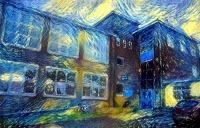 I don’t believe it! The Eskdale ‘Star night’ (Wednesday 22nd) unfortunately coincided with the only bad weather night of the week so our planned outdoor observations were quite out of the question. No scopes then, but with a new looking inflatable planetarium brought over and manned by York University boffins, who needed clear skies. All we needed was somewhere to use for the scale solar sytem(s). An ideal location was at hand – the main school corridor, which at nearly 60 mtrs long was tailormade for our demo.
I don’t believe it! The Eskdale ‘Star night’ (Wednesday 22nd) unfortunately coincided with the only bad weather night of the week so our planned outdoor observations were quite out of the question. No scopes then, but with a new looking inflatable planetarium brought over and manned by York University boffins, who needed clear skies. All we needed was somewhere to use for the scale solar sytem(s). An ideal location was at hand – the main school corridor, which at nearly 60 mtrs long was tailormade for our demo.
I say system(s) because two scale systems were laid out over the floor tiles; the Trappist1 system – recently highlighted in the media due to the number of ‘habitable zone planets’ detected, as well as our own system. At less than half a metre, the Trappist system really didn’t stretch our legs along the corridor, but it did bring home just how ‘intimate’ this seven planet system is huddled around its red dwarf sun. Our own system did though task the legs of participating school pupils and parents, the narrow confines seemingly focusing the mind on the distances of the outer planets.
Perhaps not the evening we were hoping for, but feedback post event was very positive, stimulating the old brain cells in young and old alike. Thanks to both ‘Andies’ for their help, either making the Trappist system or assistance on the night.
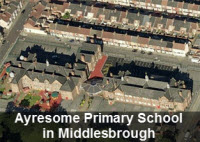 Just to reminder that we shall be hosting a star party event for visiting pupils from Ayresome Primary School & Lego Innovation Studio up at the Whitby Youth Hostel on April 12th. Elizabeth Labelle; assistant Head Teacher was impressed with the pupil response and feedback after last year’s inaugural event, and has contacted the society with regards to host another one this year. The start time is around 20:30h at the WHA on the east cliff.
Just to reminder that we shall be hosting a star party event for visiting pupils from Ayresome Primary School & Lego Innovation Studio up at the Whitby Youth Hostel on April 12th. Elizabeth Labelle; assistant Head Teacher was impressed with the pupil response and feedback after last year’s inaugural event, and has contacted the society with regards to host another one this year. The start time is around 20:30h at the WHA on the east cliff.
Cosmology Corner
 It all started in 1924, when Edwin Hubble proved galaxies are very distant objects, each containing millions or billions of stars, bound together by gravity. Within a few years, he set up a system to classify these galaxies by shape; a system which is still pretty much the system we use today.
It all started in 1924, when Edwin Hubble proved galaxies are very distant objects, each containing millions or billions of stars, bound together by gravity. Within a few years, he set up a system to classify these galaxies by shape; a system which is still pretty much the system we use today.
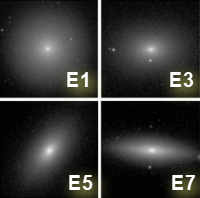 Eliptical galaxies
Eliptical galaxies
- Elipticals are marked with the letter E, sub-divided 0-7, where 0 is completely round and 7 is very elongated and flattened.
- The contain many old stars with very little dust between them. As stars form from dust, that kind of makes them dying galaxies without the raw ingredients to form many new stars.
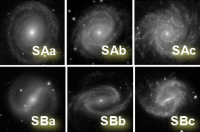 Spiral Galaxies
Spiral Galaxies
- There are Regular spirals (S) and barred spirals (SB). About 2/3 of spiral galaxies have a bar, probably including our own Milky Way. Spiral galaxies are sub-divided A-C where A has spirals tightly wound around the central bulge and in C the spirals are very loose.
- They have a mixture of old and new stars, which are particularly created in their spiral arms.
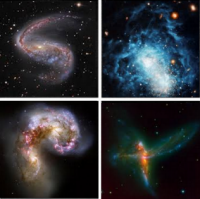 Irregular galaxies
Irregular galaxies
- Irregulars have a disk around a central bulge, but no obvious dust lanes. The have no sub-divisions.
- They often have many bright young stars. Galaxies can change their shape over time through interactions, collisions and mergers. These interactions stimulate massive star formation. If you're thinking that irregular galaxies have been messed-up and shaken-up by this kind of interaction, you're on the right track.
Galaxies also come in a range of sizes
- The Milky Way is a large galaxy (although there are many both larger and smaller).
- There are also Dwarf galaxies, like the near-by Small and Large Magellanic Clouds. Astronomers think that the total mass of all Dwarf galaxies exceeds the mass of the Large galaxies.
Changes to Hubble's galaxy classifcation system consider brightness, and whether arms spiral outward from a ring of stars. These changes help astronomers to understand more about their birth and eventual death.
 The video and material for this article was made by UK Astrophysicist Sebastian Pines, creator of the 'Astronomic' YouTube channel. You can support Seb's work creating videos that help to teach the world about astronomy by sponsoring a dollar or two per month via his Patreon page.
The video and material for this article was made by UK Astrophysicist Sebastian Pines, creator of the 'Astronomic' YouTube channel. You can support Seb's work creating videos that help to teach the world about astronomy by sponsoring a dollar or two per month via his Patreon page.


